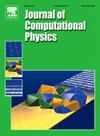Multiscale extended finite element method (MS-XFEM): Analysis of fractured geological formations under compression
IF 3.8
2区 物理与天体物理
Q2 COMPUTER SCIENCE, INTERDISCIPLINARY APPLICATIONS
引用次数: 0
Abstract
The activation of fracture networks poses significant risks and raises safety concerns for projects involving such geological structures. Consequently, an accurate and efficient simulation strategy is essential for modeling highly fractured subsurface formations. While the extended finite element method (XFEM), coupled with the penalty method, effectively models slip-stick conditions along fracture surfaces and fracture propagation under compression, its efficiency declines when handling dense fracture networks. To address this challenge, a multiscale XFEM (MS-XFEM) approach is developed and presented. MS-XFEM approximates fine-scale displacement field by interpolating solutions on a coarser-scale mesh using algebraically constructed basis functions. All extra degrees of freedom (DOFs) are incorporated within the basis functions matrix, rendering the coarse-scale system a standard finite element-based system. In each propagation step, basis functions are algebraically and locally updated to capture fracture propagation. Through four proof-of-concept test cases, the accuracy and efficiency of MS-XFEM in simulating fractured geological formations are demonstrated, emphasizing its potential for real-world applications.
多尺度扩展有限元法(MS-XFEM):压缩条件下裂缝性地质构造分析
裂缝网络的激活带来了巨大的风险,并引发了涉及此类地质结构的项目的安全问题。因此,准确、高效的模拟策略对于高裂缝地下地层的建模至关重要。扩展有限元法(XFEM)与惩罚法相结合,可以有效地模拟沿裂缝表面的滑移情况和裂缝在压缩下的扩展,但在处理密集裂缝网络时,其效率下降。为了解决这一挑战,开发并提出了一种多尺度XFEM (MS-XFEM)方法。MS-XFEM利用代数构造的基函数在较粗尺度网格上插值解,逼近精细尺度位移场。所有额外的自由度(dof)都被纳入基函数矩阵中,使粗尺度系统成为一个标准的基于有限元的系统。在每个扩展步骤中,基函数进行代数和局部更新以捕获裂缝扩展。通过四个概念验证测试案例,验证了MS-XFEM在模拟裂缝性地质构造方面的准确性和效率,强调了其在实际应用中的潜力。
本文章由计算机程序翻译,如有差异,请以英文原文为准。
求助全文
约1分钟内获得全文
求助全文
来源期刊

Journal of Computational Physics
物理-计算机:跨学科应用
CiteScore
7.60
自引率
14.60%
发文量
763
审稿时长
5.8 months
期刊介绍:
Journal of Computational Physics thoroughly treats the computational aspects of physical problems, presenting techniques for the numerical solution of mathematical equations arising in all areas of physics. The journal seeks to emphasize methods that cross disciplinary boundaries.
The Journal of Computational Physics also publishes short notes of 4 pages or less (including figures, tables, and references but excluding title pages). Letters to the Editor commenting on articles already published in this Journal will also be considered. Neither notes nor letters should have an abstract.
 求助内容:
求助内容: 应助结果提醒方式:
应助结果提醒方式:


